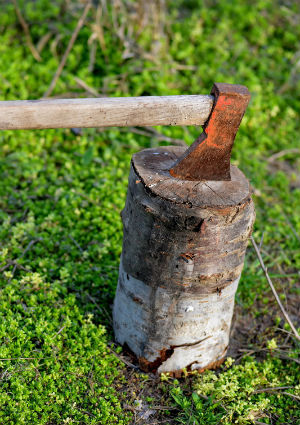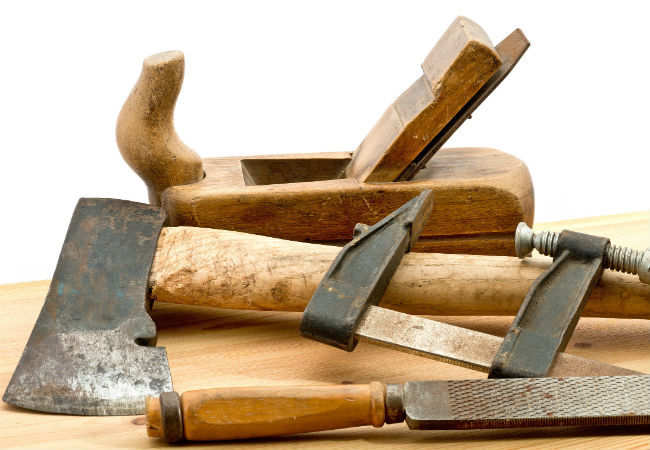We may earn revenue from the products available on this page and participate in affiliate programs. Learn More ›
Few outdoor chores are as inherently hazardous as cutting down trees or chopping up wood, especially when your axe is subject to heavy use. Working with a dull axe is not only ineffective, but it’s also downright dangerous. A worn or damaged blade may bounce or glance off the wood rather than making a clean cut. Fortunately, sharpening an axe is a fairly simple procedure, requiring only a few easily gathered tools and some straightforward steps. Remember: Sharpening any tool is a task that requires undivided attention and proper safety equipment. Always wear protective goggles over your eyes, don sturdy gloves on your hands, and equip yourself with the proper guidelines for how to sharpen an axe.
Tools & Materials
Bobvila.com may earn a commission from purchases made through these links.

Step 1
Clean the axe head well to remove rust and reveal any chips or gouges. If you find major damage, consider first using a grinding wheel to create a clean, straight edge. Don’t try to do it all in one pass—a little bit of grinding goes a long way! Use short strokes with the wheel, and pause between each to allow the steel to cool before continuing. Alternatively, you can dip the axe head in a bucket of cold water between passes. If there are only small nicks, you can skip this step and proceed directly to filing.
Step 2
Clamp the axe handle into a bench vise. Begin perfecting the surface by running a 10-inch bastard file along one side of the bevel of the blade, keeping in mind that the ideal angle is between 25 and 30 degrees (you can check the angle with a bevel gauge). Work on one side at a time, filing slowly and pushing the file away from you in long, smooth strokes. Do not use a push-pull motion; if the tool makes contact with the blade on the return stroke, you may damage the file—and you won’t get your blade any sharper. Use a wire brush to remove metal shavings that come about as you practice how to sharpen an axe. Keep count of the number of strokes you use on this side of the blade, as you’ll want to apply the same number to the other side.
Step 3
Continue filing evenly until a burr of metal, called a “wire edge,” appears at the apex of the cutting edge on the side of the blade opposite to the one you’re filing. Turn the axe over and repeat the filing process, using the same number of strokes you used on the first side to ensure that you don’t end up with an asymmetrical blade. Be careful to keep the edge beveled and centered on the head.
Step 4
Once you have a nice, sharp edge, hone the blade using a dual-sided sharpening stone. Run the coarse grit over one side of the blade using a circular motion, remembering again to count the number of strokes you use. After applying the same number of coarse strokes to the opposite side of the blade, repeat this process with the fine side of the stone.
Step 5
Once you’ve mastered how to sharpen an axe, keep your cutting tool in fine fettle by remembering to apply a protective coating of beeswax, linseed oil, or machine oil to the head after each use. Dispense a liberal amount onto a rag, then rub it in and buff it so the entire axe head is covered and protected.


